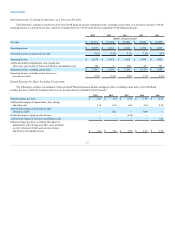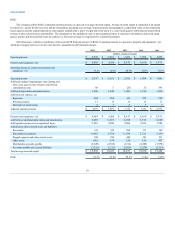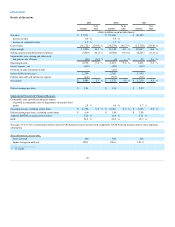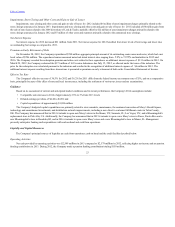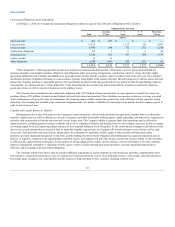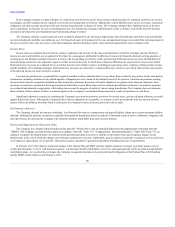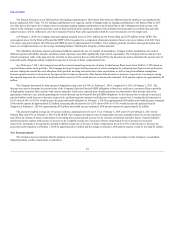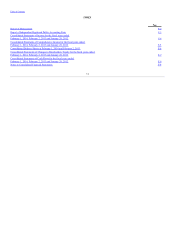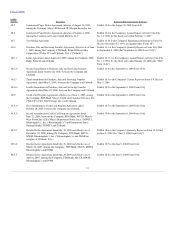Macy's 2013 Annual Report Download - page 32
Download and view the complete annual report
Please find page 32 of the 2013 Macy's annual report below. You can navigate through the pages in the report by either clicking on the pages listed below, or by using the keyword search tool below to find specific information within the annual report.
Table of Contents
Critical Accounting Policies
Merchandise Inventories
Merchandise inventories are valued at the lower of cost or market using the last-in, first-out (LIFO) retail inventory method. Under the retail inventory
method, inventory is segregated into departments of merchandise having similar characteristics, and is stated at its current retail selling value. Inventory retail
values are converted to a cost basis by applying specific average cost factors for each merchandise department. Cost factors represent the average cost-to-retail
ratio for each merchandise department based on beginning inventory and the fiscal year purchase activity. At February 1, 2014 and February 2, 2013,
merchandise inventories valued at LIFO, including adjustments as necessary to record inventory at the lower of cost or market, approximated the cost of such
inventories using the first-in, first-out (FIFO) retail inventory method. The application of the LIFO retail inventory method did not result in the recognition of
any LIFO charges or credits affecting cost of sales for 2013, 2012 or 2011. The retail inventory method inherently requires management judgments and
estimates, such as the amount and timing of permanent markdowns to clear unproductive or slow-moving inventory, which may impact the ending inventory
valuation as well as gross margins.
Permanent markdowns designated for clearance activity are recorded when the utility of the inventory has diminished. Factors considered in the
determination of permanent markdowns include current and anticipated demand, customer preferences, age of the merchandise and fashion trends. When a
decision is made to permanently mark down merchandise, the resulting gross profit reduction is recognized in the period the markdown is recorded.
Physical inventories are generally taken within each merchandise department annually, and inventory records are adjusted accordingly, resulting in the
recording of actual shrinkage. Physical inventories are taken at all store locations for substantially all merchandise categories approximately three weeks before
the end of the fiscal year. Shrinkage is estimated as a percentage of sales at interim periods and for this approximate three-week period, based on historical
shrinkage rates. While it is not possible to quantify the impact from each cause of shrinkage, the Company has loss prevention programs and policies that are
intended to minimize shrinkage, including the use of radio frequency devices and interim inventories to keep the Company's merchandise files accurate.
The Company receives certain allowances as reimbursement for markdowns taken and/or to support the gross margins earned in connection with the
sales of merchandise. These allowances are generally credited to cost of sales at the time the merchandise is sold in accordance with ASC Subtopic 605-50,
“Customer Payments and Incentives.” The Company also receives advertising allowances from approximately 1,000 of its merchandise vendors pursuant to
cooperative advertising programs, with some vendors participating in multiple programs. These allowances represent reimbursements by vendors of costs
incurred by the Company to promote the vendors' merchandise and are netted against advertising and promotional costs when the related costs are incurred in
accordance with ASC Subtopic 605-50. Advertising allowances in excess of costs incurred are recorded as a reduction of merchandise costs. The
arrangements pursuant to which the Company's vendors provide allowances, while binding, are generally informal in nature and one year or less in duration.
The terms and conditions of these arrangements vary significantly from vendor to vendor and are influenced by, among other things, the type of merchandise
to be supported. Although it is highly unlikely that there will be any significant reduction in historical levels of vendor support, if such a reduction were to
occur, the Company could experience higher costs of sales and higher advertising expense, or reduce the amount of advertising that it uses, depending on the
specific vendors involved and market conditions existing at the time.
Long-Lived Asset Impairment and Restructuring Charges
The carrying values of long-lived assets are periodically reviewed by the Company whenever events or changes in circumstances indicate that the
carrying value may not be recoverable, such as historical operating losses or plans to close stores before the end of their previously estimated useful lives.
Additionally, on an annual basis, the recoverability of the carrying values of individual stores are evaluated. A potential impairment has occurred if projected
future undiscounted cash flows are less than the carrying value of the assets. The estimate of cash flows includes management's assumptions of cash inflows
and outflows directly resulting from the use of those assets in operations. When a potential impairment has occurred, an impairment write-down is recorded if
the carrying value of the long-lived asset exceeds its fair value. The Company believes its estimated cash flows are sufficient to support the carrying value of
its long-lived assets. If estimated cash flows significantly differ in the future, the Company may be required to record asset impairment write-downs.
27


